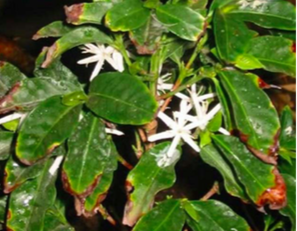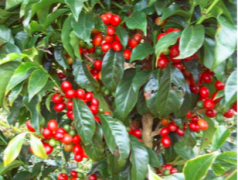Costa Rica Centro Estate Vera Sasaki Red Honey Treated Coffee Bean Flavor Taste Aroma Description

For professional baristas, please follow the coffee workshop (Wechat official account cafe_style)
Costa Rica Central Valley Brumas El Centro Villa Sarchi Red Honey
Treatment of Vera sa odd red honey in Centro Manor of Brumas processing Plant in the Central Valley of Costa Rica
The Brumas Microprocessing Plant (Brumas del Zurqui), nicknamed the King of Honey, is familiar to almost everyone in Taiwan's boutique coffee industry.
Won the Cup of Excellence Cup in 2012.
Don't miss the Honey King, who must drink it every year.
National Costa Rica (Costa Rica)
The valley in the middle of the producing area (West Valley), the micro-producing area of San Isidro
Location Costa Rica, Heredia, San Isidro, San Francisco
Microprocessing plant Brumas del Zurqui
Alvarado Rodriguez, the landowner.
Year of establishment 2002
1600 m above sea level
Planting varieties (this batch is Hongkaduai)
Treatment method red honey treatment
Flavor description:
Gaoshan pear, ripe orange fruit, floral notes,
Baked walnut, elegant sour but lively, black sugar aftertaste
Brumas del zurqui, who won the champion of Costa Rica National Coffee Competition in 2006
The local meaning is "a valley full of clouds".
Juan Ramon Alvarado, the owner of the estate, has a degree in agriculture from EARTH University.
And his wife Natalia are the fourth generation coffee farmers.
The Brumas Micro processing Plant was established in 2004.
About 750 bags of coffee are produced every year.
He uses the BRIX meter to measure sugar to determine the best harvest time for coffee cherries.
According to Juan Ramon's test results,
The best flavor performance point for sweet and sour balance is when the sugar content reaches 15.5%.
After the coffee is picked, the peel is removed first, and the pulp scraper is used to control the degree of peeling.
Retain a certain degree of sticky pulp layer (mucilage)
Next, it is different from the traditional washing treatment.
No fermentation is needed to remove the sticky pulp layer
On the contrary, let it dry directly with this layer of sticky material.
Then directly remove the sticky layer and shell (parchment).
Juan Ramon calls the coffee produced by this treatment Honey Coffee.
This low acidity, high complexity, sweet and full-bodied flavor
Through a stable, uniform and prudent exposure process
Let the sugars and alcohols contained in the surrounding residual pectin
Increase sweetness and fuller texture through diffusion
After that, the net bed is used for drying.
The water consumption of this treatment is only 5% of that of the traditional washing plant.
It can be made without huge washing trough and exposure square.
The display of flavor depends on the degree of retention of the pulp.
The challenge handlers are careful and courageous.
Although in the process of treatment, the pulp will become moldy due to too much drying failure.
Excessive fermentation caused by uneven or rapid exposure. Equal risk
But this new treatment has become a trend in Central America in recent years.
And shine in all kinds of coffee competitions.
Everyone's taste is not necessarily what they like.
You can consider buying a small amount and trying different baking degrees.
Soy beans in an explosion
Drop the beans at the end of the explosion.
Drop the beans from the end of the first explosion to the second explosion.
Touch the beans under the second explosion.
Put the beans into the second explosion for 10-15 seconds
The second explosion of dense beans
I hope you bakers can find a more favorite flavor.
Important Notice :
前街咖啡 FrontStreet Coffee has moved to new addredd:
FrontStreet Coffee Address: 315,Donghua East Road,GuangZhou
Tel:020 38364473
- Prev

Guatemala Sleeping Beauty Estate Fine Coffee Bean Flavor Taste Aroma Description Roast Curve
Professional barista communication, please pay attention to coffee workshop (Weixin Official Accounts cafe_style) Guatemala El Quich Finca La Perla flavor description: rose peach, sweet peach aroma, acid lively and bright, fruit juice feeling obvious, taste thick and soft balance, good aftertaste sweetness Guatemala has seven coffee producing areas produced coffee beans are Arabica, all located in subtropical
- Next

Description of flavor and flavor of fine coffee beans treated with 1900m honey in Mozart, Costa Rica
For professional baristas, please follow the coffee workshop (Wechat official account cafe_style) Central America Costa Rica Canet Musician Series Mozart 1900m Costa Rica Mozart (aroma of flower and fruit wine) 1900m honey treated coffee producing area: Tarrazu Annual rainfall: 1300 mm grading Standard: SHB Coffee Variety: Yellow Catuai Annual average temperature: 2
Related
- Detailed explanation of Jadeite planting Land in Panamanian Jadeite Manor introduction to the grading system of Jadeite competitive bidding, Red bid, Green bid and Rose Summer
- Story of Coffee planting in Brenka region of Costa Rica Stonehenge Manor anaerobic heavy honey treatment of flavor mouth
- What's on the barrel of Blue Mountain Coffee beans?
- Can American coffee also pull flowers? How to use hot American style to pull out a good-looking pattern?
- Can you make a cold extract with coffee beans? What is the right proportion for cold-extracted coffee formula?
- Indonesian PWN Gold Mandrine Coffee Origin Features Flavor How to Chong? Mandolin coffee is American.
- A brief introduction to the flavor characteristics of Brazilian yellow bourbon coffee beans
- What is the effect of different water quality on the flavor of cold-extracted coffee? What kind of water is best for brewing coffee?
- Why do you think of Rose Summer whenever you mention Panamanian coffee?
- Introduction to the characteristics of authentic blue mountain coffee bean producing areas? What is the CIB Coffee Authority in Jamaica?

